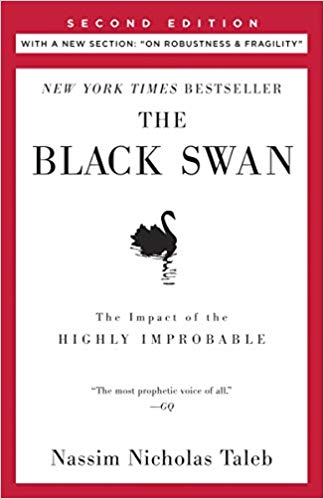

This article is an excerpt from the Shortform summary of "The Black Swan" by Nassim Taleb. Shortform has the world's best summaries of books you should be reading.
Like this article? Sign up for a free trial here .
What is a black swan in finance? Is there a way to predict and prepare for black swans in finance?
We’ll look at some examples of black swans in the financial world and business and explore how to best prepare for future black swans.
Black Swans
The Black Swan is the second book in former options trader Nassim Nicholas Taleb’s five-volume series on uncertainty. This book analyzes so-called “Black Swans”—extremely unpredictable events that have massive impacts on human society.
In his April 2007 review of The Black Swan in the New York Times, Gregg Easterbrook, riffing on the author’s skepticism about forecasts of any kind, noted, “At the beginning of 2006, the Wall Street Journal forecast a bad year for stocks; the Dow Jones Industrial Average rose 16% that year. (Disturbingly, the Journal has forecast a good year for 2007.)” Mere months later, the world economy would be in a tailspin—and Nassim Nicholas Taleb, who in The Black Swan warned that the global financial system was vulnerable to collapse, would be treated as a seer. Black swans in business and finance are rare, but they have monumental consequences.
The Black Swan is named after a classic error of induction wherein an observer assumes that because all the swans he’s seen are white, all swans must be white. Black Swans have three salient features:
- They are rare (statistical outliers);
- They are disproportionately impactful; and, because of that outsize impact,
- They compel human beings to explain why they happened—to show, after the fact, that they were indeed predictable.
Taleb’s thesis, however, is that Black Swans, by their very nature, are always unpredictable—they are the “unknown unknowns” for which even our most comprehensive models can’t account. The fall of the Berlin Wall, the 1987 stock market crash, the creation of the Internet, 9/11, the 2008 financial crisis—all are Black Swans. Many black swans in finance have a huge economic impact.
Once Taleb introduces the concept of the Black Swan in finance, he delves into human society and psychology, analyzing why modern civilization invites wild randomness and why humans can neither accept nor control that randomness.
Extremistan is defined by extreme concentration—of prestige, income, capital, influence, size, or what have you. These concentrations create the appearance of stability—larger, more powerful entities are more resilient—but they actually create the potential for catastrophic black swans.
The example par excellence of the risks of concentration is the banking industry. The explosive growth and interrelation of the major global financial institutions were the catalysts for the Great Recession of 2008.
Limits of the Bell Curve and Black Swans in Finance
One of the reasons black swans in finance are so visible is that they have a huge impact and they’re rarely predicted. One of the reasons black swans in business and finance surprise us is that analysts use the wrong tools.
The classic bell curve—which is also called the “Gaussian distribution” after German mathematician Carl Friedrich Gauss—is an accurate description of Mediocristan phenomena, but it is dangerously misleading when it comes to Extremistan.
Black Swans in Finance, Example #1
In our contemporary moment, the most egregious misuse of bell curves can be found among economists and financial-industry analysts. Most economists, including many Nobel Prize–winners, treat financial markets as though they hail from Mediocristan when, in fact, they’re from Extremistan.
A stunning example of economists’ misinterpretation of the market came in 1998, with the collapse of Long-Term Capital Management (LCTM), a hedge fund that included among its founding partners two Nobel Prize–winners, Myron Scholes and Robert C. Merton (Robert K. Merton’s son). Scholes and Merton won their Nobel Prize for a theory of stock option pricing; the theory, however, was based on a Gaussian model of the market that excluded the possibility of Black Swans.
When markets were disrupted by the Asian financial crisis of 1997 and the Russian financial crisis of 1998—a one-two punch of Black Swans—Scholes and Merton’s theory was revealed for the fantasy it was. The twin crises resulted in a crushing $4.6 billion loss for LCTM in fewer than four months. The firm had to be bailed out by a consortium of private banks, at the behest of the Federal Reserve.
The problem is that economists’ models are thoroughly Platonified: self-consistent, but bearing almost no resemblance to reality. Economists are like philosopher John Locke’s madmen: they reason “correctly from erroneous premises.” This causes us to be totally unprepared for black swans in finance.
Flawed Methods of Predicting Black Swans in Finance
Why are we so impacted by black swans in finance? Because experts both (1) “tunnel” into the norms of their particular discipline and (2) base their predictive models exclusively on past events, their predictions are inevitably susceptible to the extremely random and unforeseen.
Black Swans in Finance, Example #2
Consider, for example, a financial analyst predicting the price of a barrel of oil in ten years. This analyst may build a model using the gold standards of her field: past and current oil prices, car manufacturers’ projections, projected oil-field yields, and a host of other factors, computed using the techniques of regression analysis. The problem is that this model is innately narrow. It can’t account for the truly random—a natural disaster that disrupts a key producer, or a war that increases demand exponentially.
Taleb draws a key distinction between experts in Extremistan disciplines (economics, finance, politics, history) and Mediocristan disciplines (medicine, physical sciences). Experts like biologists and astrophysicists are able to predict events with fair accuracy; experts like economists and financial planners are not.
In Finance, Adopt the “Barbell Strategy”
When Taleb was a trader, he pursued an idiosyncratic investment strategy to inoculate himself against a Black Swan in finance. He devoted 85%–90% of his portfolio to extremely safe instruments (Treasury bills, for example) and made extremely risky bets—in venture-capital portfolios, for example—with the remaining 10%–15%. (Another variation on the strategy is to have a highly speculative portfolio but to insure yourself against losses greater than 15%.) The high-risk portion of Taleb’s portfolio was highly diversified: He wanted to place as many small bets as possible to increase the odds of a Black Swan in finance paying off in his favor.
The “barbell strategy” is designed to minimize the pain of a negative Black Swan while, potentially, reaping a positive Black Swan’s benefits. If the market collapses, a person pursuing this strategy isn’t hurt beneath the “floor” of the safe investments (say, 85%), but if the market explodes, he has a chance to capitalize by virtue of the speculative bets.
History of Taleb’s Fascination with Black Swans in Finance
When and where did Taleb first come up with the idea of the black swan in finance?
In the 1980s, as the war in Lebanon continued to rage, Taleb found himself in business school at the University of Pennsylvania’s Wharton School. There, he discovered that the triplet of opacity didn’t just affect his countrymen—it affected his professors and the powerful corporate executives who came to lecture as well. Taleb realized that no one—not even the “smartest” businesspeople in the world—was prepared for Black Swan events.
That realization became even more stark on October 19, 1987, when global stock markets crashed.
At the time, Taleb was working for Credit Suisse First Boston; his specialty, honed at Wharton, was “quantitative finance”—the application of complex mathematical models to markets to mitigate uncertainty. Taleb, however, used his knowledge as a “quant” not to apply those mathematical models directly, but to suss out where those models failed and invest accordingly. In other words, whereas everyone else was flying blind and didn’t know it, Taleb was flying blind and did know it, and he placed bets that would pay off if the models were wrong.
On the day of the crash, he was vindicated. So much so that his bonus was tantamount to “F*** you” money—that is, it was large enough that he no longer needed to work to earn money. He chose to stay in finance, but he customized his roles so that he could spend ample time in solitude and contemplation.
The focus of his sabbaticals? Uncertainty.
Black Swans in Finance, Example #3: Faulty Reasoning
An example of faulty inductive reasoning from the world of finance concerns the hedge fund Amaranth (ironically named after a flower that’s “immortal”), which incurred one of the steepest losses in trading history: $7 billion in less than a week. Just days before the company went into tailspin, Amaranth had reminded its investors that the firm employed twelve risk managers to keep losses to a minimum. The problem was that these risk managers—or suckers—based their models on the market’s past performance. The tailspin was a black swan in finance.
In order not to be suckers of black swans in business and finance, we must (1) cultivate an “empirical skepticism”—that is, a skepticism steeped in fact and observation—and (2) remain vigilant against the innately human tendencies that leave us vulnerable to Black Swans.
Who’s Most Susceptible to Black Swans in Finance?
The most arrogant group in terms of their predictions of black swans in finance—and least aware of their own ignorance—are so-called “experts.” These are the credentialed and/or laureled people whose opinions are granted weight by society.
Taleb divides this group by two. There are those who are arrogant but also display some degree of competence, and then there are those who are arrogant and incompetent.
Incompetent Arrogants
“Incompetent Arrogants” are “experts” whose predictive abilities and skills aren’t significantly greater than the average person’s. This group includes stockbrokers, intelligence analysts, clinical psychologists, psychiatrists, economists, finance professors, and personal financial advisors.
In numerous empirical studies, the forecasting ability of the “incompetent arrogants” has been shown to be almost nonexistent.
For example, over the course of several years, psychologist Philip Tetlock asked almost 300 specialists—political scientists, economists, journalists, and politicians—to offer predictions of world events (the timeframe was usually “within the next five years”). He discovered that the experts’ predictions were barely more accurate than random selection and often worse than simple computer simulations.
He also found that the more prominent a person was in his or her field, the worse were his or her predictions. The reason for this finding was that prominent people tend to become prominent based on their having one big idea. These experts marry themselves to their singular idea and neglect other possibilities—and thus, when randomness rears its head, they’re shown to have been woefully misguided.
Tetlock’s main interest, however, wasn’t the fact of experts’ poor forecasting abilities but rather those experts’ lack of accountability for being wrong. He found that experts (unconsciously) employ a number of excuses to explain away their errors.
A major problem with financial and governmental projections is that they don’t incorporate a margin of error. That is, the authors of these projections don’t take into account (nor do they publicize) how significantly their projections might be off-target.
Preparing for Black Swans in Finance
Distinguish Between Positive Contingencies and Negative Ones
Different areas of society have different exposure to Black Swans, both positive and negative.
For example, scientific research and moviemaking are “positive Black Swan areas”—catastrophes are rare, and there is always the possibility of smashing success. The stock market or catastrophe insurance, meanwhile, are “negative Black Swan areas”—upsides are relatively modest compared to the possibility of financial ruin.
It’s important to note that the history of a negative–Black Swan area will underrepresent the possibility of catastrophe. An obvious example is financial markets, which always appear stable until they crash. Positive–Black Swan areas, oppositely, will underrepresent the possibility of serendipity: Despite years of research, a cure for cancer hasn’t been found; but one could be found any day.
Suffice it to say, we should take more risks in a positive Black Swan area in finance than in a negative Black Swan one.
———End of Preview———

Like what you just read? Read the rest of the world's best summary of "Black Swan" at Shortform . Learn the book's critical concepts in 20 minutes or less .
Here's what you'll find in our full Black Swan summary :
- Why world-changing events are unpredictable, and how to deal with them
- Why you can't trust experts, especially the confident ones
- The best investment strategy to take advantage of black swants






